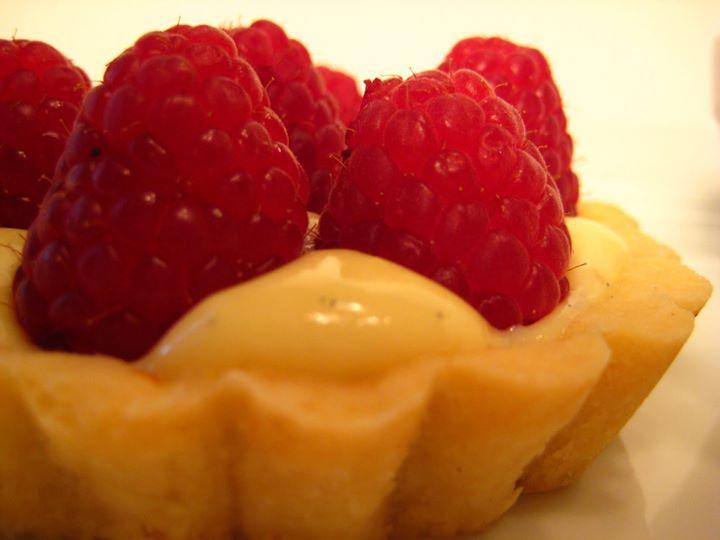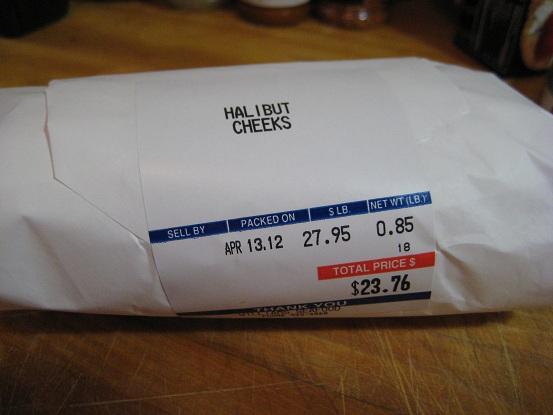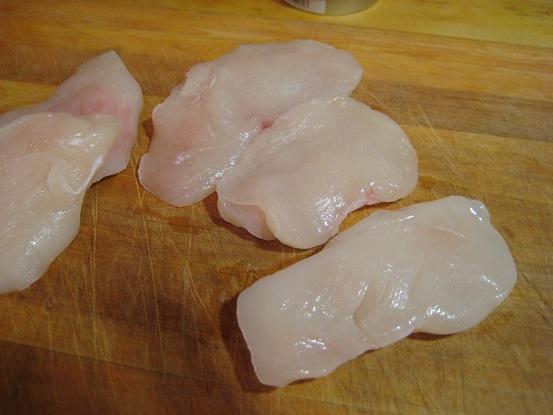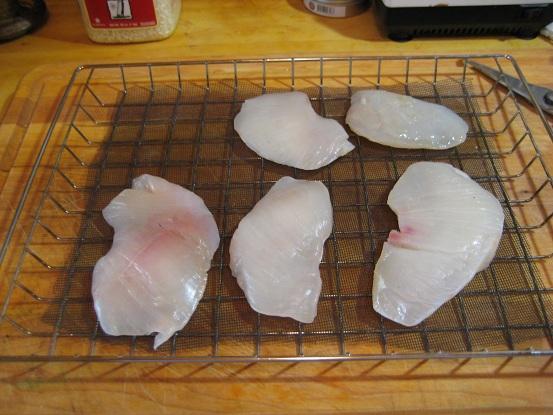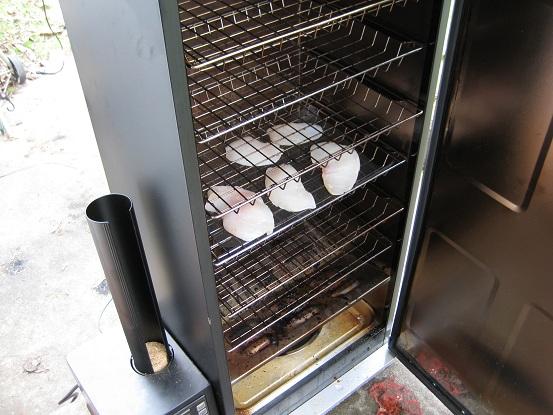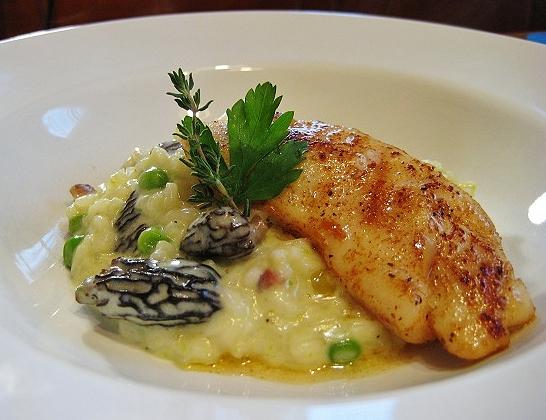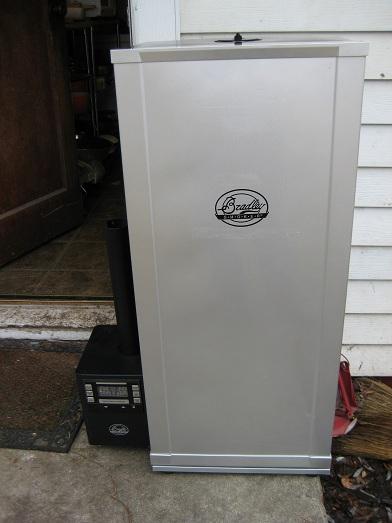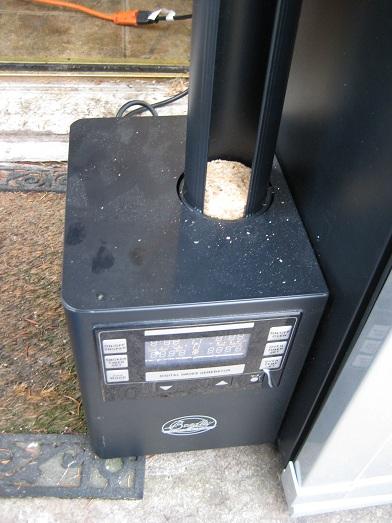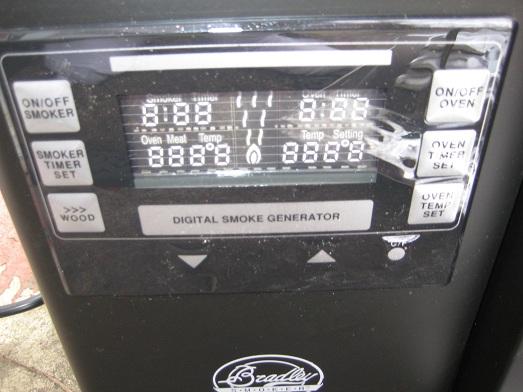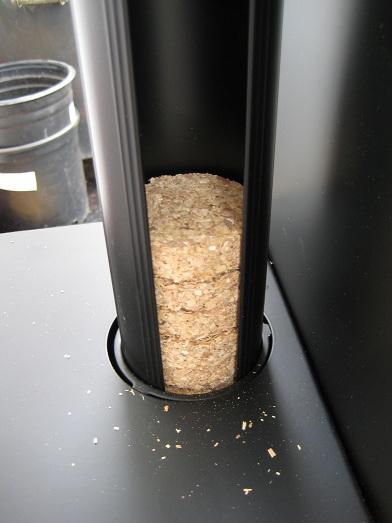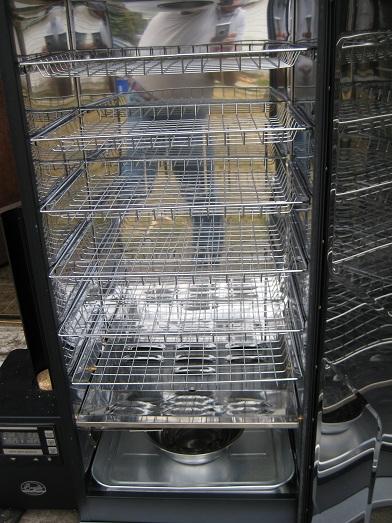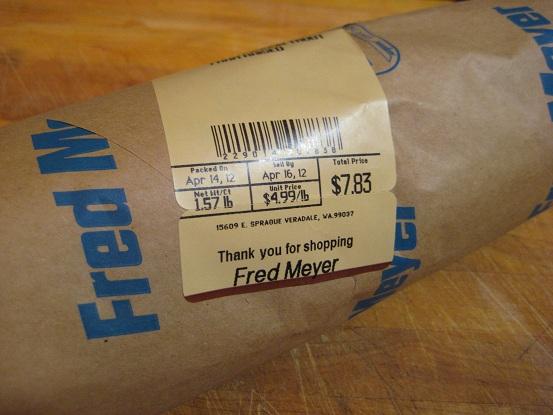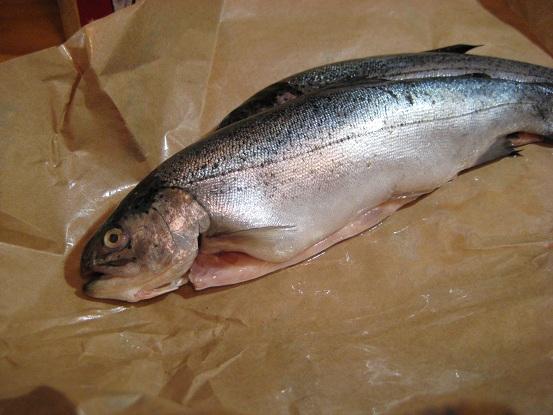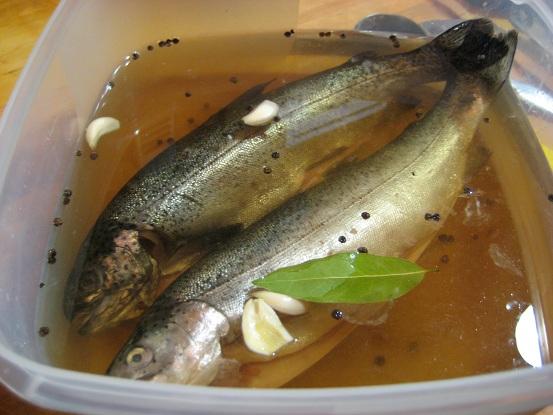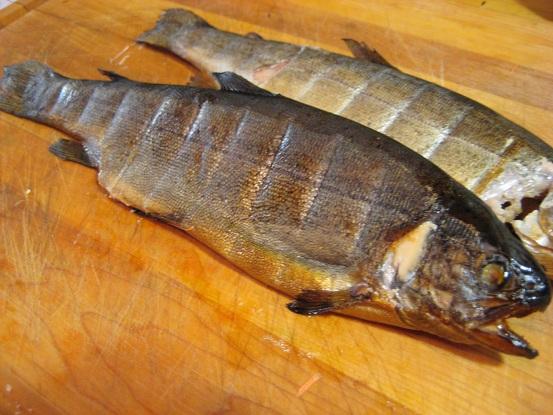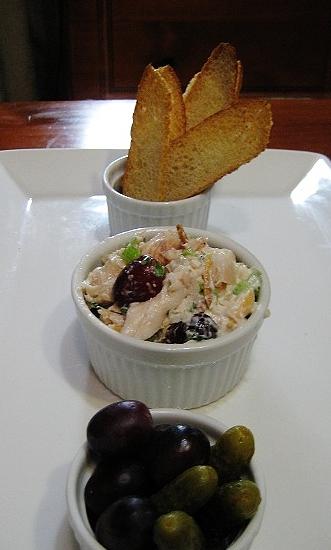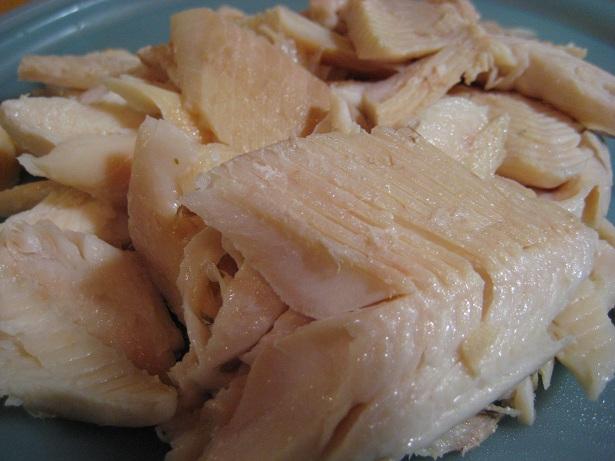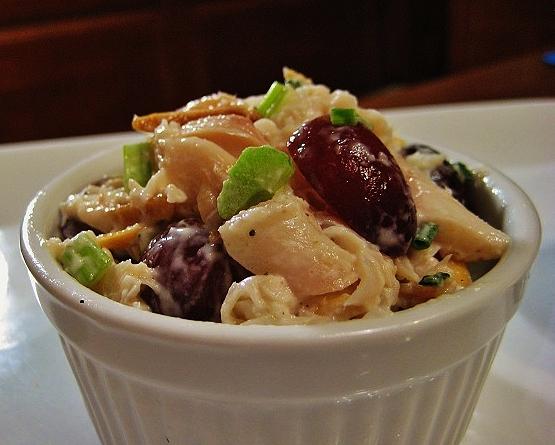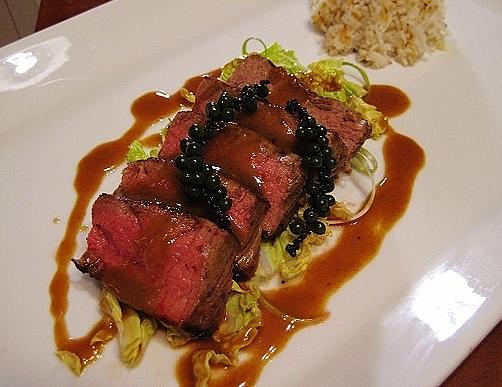-
Posts
5,035 -
Joined
-
Last visited
Content Type
Profiles
Forums
Store
Help Articles
Everything posted by David Ross
-
Thanks. It's a recipe I got from Chef Alex Stratta a few years back when he was still working as the Executive Chef at Restaurant Alex at the Wynn, Las Vegas. I changed up the recipe by adding applewood smoked bacon and morels. I wanted a recipe that wouldn't overpower the halibut and say Northwest but still stay close to Chef Alex's dish. You add both whole peas and pea puree to maximize the flavor.There isn't a lot of parmesan in this risotto, the richness and creamy texture come from a good amount of both butter and whipped cream. You can read about this wonderful risotto and see our friend Jeff Meeker furiosuly stir it at our report on Vegas Uncork'd 2010 here.
-
Thanks. The halibut turned out with just a hint of smoke. It's so easy to prepare once you get through the brining and smoking steps--just sauteed for 2 minutes or so on each side. I was worried that a creamy risotto would be too heavy for the fish but it worked out just fine.
-
It's very simple. You light the end of it, and it burns like a giant mosquito coil:) Looks really convenient. So do you just restock it with wood chips each time you use it? How much does a unit like that cost? Seems easy and probably economical for smoking for those who don't want a big unit like I'm using.
-
My second experiment involved cold-smoking Halibut Cheeks. If you aren't familiar with Halibut Cheeks, we consider them a rare delicacy here in the Pacific Northwest. Years ago, the only wise people that cut the cheeks out of the Halibut were Native Alaskans or Fishermen. Probably no fish buyer in his right mind would buy Halibut Cheeks and resell them on the retail market. Who would buy the cheek out of a bottom-feeder? The Father of a lady I work with runs a fleet of fishing boats in Alaska. He barters with Japanese fishermen, trading Halibut Cheeks for Tuna. I don't think there's a loser in that transaction. Of course, people like us who crave the unusual have pushed the Halibut Cheek into popularity among the food cognescenti. Halibut Cheeks have found their way into the lexicon of Chefdom today and you'll find them in trendy guises on restaurant menus. If Halibut Cheeks are the daily special, order them. The texture of a Halibut Cheek is akin to Skate Wing-tender, white flesh with strands of meat rather than the large, chunky flakes of a halibut filet. The flavor is buttery-soft. There isn't a lot of oil in the flesh of a Halibut, so you have to treat it accordingly--a light touch in the skillet, oven or smoker so the fish doesn't dry out. Because it has a tender nature, I decided to cold-smoke the Halibut Cheeks. As you can see, the unwanted parts of a Halibut don't come cheap- My Fishmonger told me these cheeks came from Halibut in the 30-50lb., range. (You've probably seen photos of fishermen posing beside a 400lb. Halibut. It makes for a nice memory of a vacation, but those behemoths aren't prized for tender meat)- I used the same basic brine for the Halibut Cheeks that I used for the Smoked Trout with a few changes- 10 cups water 1/4 cup Kosher salt 1/3 cup honey (substituted for the brown sugar) 1 tbsp. peppercorns 2 cloves garlic 1 bay leaf 1/2 onion, chopped (not used for the Trout) 2-3 stalks fresh parsley (not used for the Trout) The Halibut Cheeks were left in the brine overnight. (The Trout was brined for 7 hours). After brining, I let the Halibut Cheeks rest at room temperature, uncovered, for about 4 hours to form a "pellicle," drying out the flesh and allowing for more smoke absorption. The Halibut Cheeks laying on the "screen" on top of the smoker rack- The Halibut Cheeks into the smoker- I cold-smoked the Halibut Cheeks for 2 hours using Alderwood. Alder is the wood we traditionally use in the Northwest to smoke and cook salmon. It gives a mild, herbal-woodsy tone to fish without overpowering it with an acrid smoke taste. At this point the Halibut Cheeks weren't cooked, so I had to find a delicate dish that I thought would bring out the smoke flavor and relate to my roots in the Northwest. Seasoned with a very light sprinkle of salt and pepper, I sauteed the Cheeks in butter and olive oil. The Halibut was paired with a Spring Pea Risotto with Bacon and Morels. What can be better than Smoked Halibut and a Creamy Risotto?
-
I've got to try the vacuum technique. In the old days we were taught to weigh down the salmom in the brine using a can of beans!
-
Thanks...and SO easy to make. The hardest part is being able to cold smoke. With products like the A Maze N smoke generator and the ProQ you can place this maze type smoke generator in any enclosed area to cold smoke. They generate smoke for several hours depending. A certain amount of air circulation is needed and will effect how fast they burn Yup, i use a ProQ. It's fantastic. Have you got photos of it so we can see how it works?
-
For years I've been struggling with an old-fashioned barrel-style barbecue smoker. You know the one, it's a big barrel laying on its side with a firebox on one end. It's economical, burning both charcoal or hardwood, and fairly easy to use. But I was always bitten by the heat bug-it was hard for me to regulate the heat with just a thermometer and a bucket of wood. In fact, it was virtually impossible for me to keep a consistent heat of 225 degrees when smoking a brisket. Smoking fish was even harder. I've also used one of those little stovetop smokers. You line the pan with foil, then sprinkle in some wood chips and place the fish on a rack over the wood. You slide on the meatal top and place the smoker on the stovetop over low heat. The only problem I've found with the stovetop smoker is that the wood heats up fairly quick, then basically burns. It's really difficult to come away with fish that isn't an acrid mess. So this Spring I busted the budget and bought a Bradley 6-Rack Digital Smoker. It's typically used by hunters and fishermen and is sold at Outdoor Stores. I got it on a special $100 off of the regular price, paying $499.99. The beauty of this smoker is that you can digitally control the heat and the smoke. You can cold-smoke, hot-smoke and cook, and each setting has a digital timer. I recently did baby back ribs in this smoker with 3 hours of smoke with an oven temperature of 220, then cooked without smoke at 275 for another 3 hours. They were every bit as good as what you'll find in any chain barbecue restaurant. For the Cook-Off, I did the trout, two types of salmon and some halibut. The smoker is about 4' high and 2' wide. The smoker box is removable and hangs off the left side of the cooker box unit- The digital control panel of the smoker box- The bisquettes are loaded into a funnel on top of the smoker box. They are automatically advanced into the cooker box unit onto a heating element. The heat creates the smoke, then every 20 minutes the used bisquette is advanced down into the water bowl and a new bisquette is advanced onto the heating unit. There is another heating element in the cooker box that can be turned off for cold-smoking- Top vent- Inside the cooker box- The drawbacks of the Bradley Digital Smoker are limited. You have to use their trademark "Bisquettes," little round discs of wood. Each bisquette lasts for 20 minutes of smoke. A box of 48 costs about $20, so you get about 16 hours of smoke from one box of bisquettes. You'd probably pay at least that much, if not more, for enough good hardwood to go 16 hours. They sell applewood, alderwood, cherry, oak, maple, mesquite, pecan, hickory and a special blend. Plenty of flavors for smoking fish. It's lightweight so I leave it in the garage when I'm not using it, then just roll it out to the patio on a dolly when I'm ready to smoke. Granted, these photos were taken a month ago when the unit was new and not yet "seasoned" with smoke. It's really cracking now and I'm putting out some delicious smoked fish and meats. I think I'm really going to love this toy.
-
That looks beautiful! I was talking with my fishmonger this weekend and I asked him about the upcoming Copper River season. He said the river is still frozen over, so we won't see any fishing activity for at least two weeks. He isn't sure what the season looks like in terms of the numbers of fish this year. He works directly with some fishermen up there so there isn't a big mark-up by a middling seafood distributor. I'm going to be on the lookout for some rich Copper River bellies to smoke.
-
I'm afraid my budget hasn't got as far as 'Modernist Cuisine' yet and I've a huge learning curve in front of me (hopefully) but can you tell me what 'to equilibrate' means in the context of the cure ? He just means for the salt to stabilize across the fish (i.e., achieve even 3% everywhere). The idea is you can put in just the right amount of salt such that you don't have to worry about over or under curing. I'm also naive when it comes to the Modernist methods. Explain a little more about the ratios. So is the 3% ratio of salt related to 3% of the weight of the fish? Or is it a ratio of 3% salt in the amount of water you are using?
-
Thanks. It tasted pretty great too.
-
I started my adventure with brining and smoking some Rainbow Trout. These trout came from Clear Springs Foods, a trout farm located on the Snake River in Southern, Idaho. The ponds are fed with pure spring water, growing trout that have a clean, fresh taste. These beauties weighed just under a pound each and sold for $4.99 per pound- I didn't want to overpower the delicate texture and mild flavor of the trout, so I used a simple brine composed of- 10 cups water 1/4 cup Kosher salt 1/3 cup brown sugar 1 tbsp. peppercorns 2 cloves of garlic, crushed 1 bay leaf 1 tbsp. Calvados, (apple brandy) I wasn't sure the Calvados would add any flavor to the trout, but I was going to be using applewood for the smoke so I thought the apple flavor of the Calvados would accent the flavor from the wood. This was a "cold" brine as opposed to a "hot brine." With a hot brine you bring the water to a boil and then add the salt and sugar so it melts into the liquid. A hot brine is cooled and then the fish is added and refrigerated to cure. In all honesty, making a cold brine is much easier, (just stir the ingredients together). I haven't been able to taste any difference in fish that is cured in a cold brine compared to a hot brine. Here are the trout in the brine. Note that I left the trout whole, I didn't think to butterfly them like ChefCrash did with his trout. Looking back on it, if I would have butterflied the trout they would have picked-up more smoke. After the fact, I figured that it was o.k. to leave the trout untouched so the meat would only pick up a hint of smoke, yet stay moist within it's natural blanket. I was going to be using the trout in a salad, so I thought it wouldn't need a heavy dose of smoke. At least that was my reasoning- The trout cured in the brine for 7 hours, then went directly into the smoker without sitting out to air-dry. (I'll be providing photos and more information on my smoker in my upcoming posts). Since trout is a delicate fish without any oil, I thought it didn't need to dry-out before smoking like I would do with salmon. So in the smoker they go, head on, skin on, bones and fins. The trout ready for the smoker- You'll note the trout are sitting on a screen that I put on top of the smoker rack. The spaces of the smoker rack are pretty large, so small items like whole fish or fish filets can fall through the holes in the rack. I use screen from Home Depot, (actual screen used for doors), cut to the size of the rack and use it as a resting spot for the fish. You need to spray it with non-stick coating so the fish won't stick to the screen, but other than that, it's a cheap and easy way to hold the fish flat on the rack. It's sort of like the non-stick metal sheets with air holes that people use for baking pizza. I hot-smoked the trout for 2 hours at 150 degrees using applewood, then turned the smoke off, increased the temperature to 170, and continued to cook the trout for another 3 hours until the flesh was firm to the touch. Then into a covered container to cool overnight- After cooling overnight, I pulled the meat off the bones. It probably would have been easier to pull the bones out when the trout was still warm, but trout are incredibly easy to clean and debone whether cold or hot. I left the meat in fairly good size chunks for both texture and the type of salad I was going to be making. It came out incredibly juicy- The trout was then crafted into a salad composed of- Red Grapes Celery Toasted Almonds Mayonnaise Lemon Juice Tarragon Chives Salt Pepper Calvados The garnishes were little garlic dill pickles and red grapes and some toasted bread slices. My meat slicer has been a gift from above when it comes to cutting anything very, very thin. I think I bought it with the intention of cutting lunch meat, but it's a marvel for cutting baguettes lengthwise into thin, little crisps. Applewood Smoked Trout Salad-
-
Looks fantastic. I like how you butterflied the trout so that the smoke would permeate the meat. When I saw your delicious photo I realized I should have butterflied the trout I smoked today. But I figure that since I'm putting it into a cold salad with other mild ingredients, I think my "closed" trout with a hint of smoke will work just fine. This is a good lesson--think about how you're going to use the fish in a final dish, (which I forgot to do but hopefully will get lucky). I think for a cold, delicate salad, letting the whole trout sit on the smoker rack is a good application. If I was going to do a stronger dish, like smoked trout in a pate, spread or just chunks of smoked trout on bread I'd probably butterfly it. Trout is the perfect fish for smoking, in part because the bone structure is so forgiving. Leave the bones attached and once the meat is cooked through, you can easily pull out the back bone with the rib bones attached. Too bad all fish aren't that easy to debone.
-
For the trout I did today my ratio was: 10 cups water 1/4 cup salt 1/3 cup brown sugar That's 1/4 the salt called for in the recipes I looked at, including the recipe booklet that came with my new digital smoker. I've had some bad luck lately with overly salted salmon that I brined or cured, so I've been gradually cutting down on the ratio until I got it to the point where it fits within my own personal tastes. I also added some black peppercorns, 1 bay leaf and a slice of lemon to the brine. Photos are on the way over the next few days of my curing/brining processes, smoking techniques and the finished dishes.
-
I've added a fourth dish to my lineup, Earl Grey Smoked Salmon based on a recipe by Chef Laurent Gras. The fuel for the smoke isn't always wood. I've made tea-smoked duck and chicken before, but I've never used tea for smoking fish. I think the herbal notes of the bergamot in the tea will be a nice accent for the rich salmon. I'm also considering using some lapsang souchong tea. It's got a deep, earthy, smokey flavor that I think would work well on fish.
-
Hmmm. That's a good question. My thought would be that Ceviche is a separate category. It's basically a raw fish dish, but the acids-lemon or lime juice-have the effect of quickly breaking down the proteins, or "cooking" the fish. I suppose you could say that it is "quick-cured," but it seems as though the basic goal of Ceviche is to take very fresh fish and add some additional ingredients and then quickly eat it. In my mind that takes it out of our realm of Cured, Brined, Smoked and Salted Fish. I'd actually contest that, since good Ceviche de Pulpo, for example, is a 5-day preparation (anything less and it's horrid and rubbery). However since most Ceviches are quick-cures, you're probably right in the broadest sense... I'll have to rehabilitate my friend's antique smoker, then, and go catch some trout! After looking at some recipes online for Ceviche de Pulpo, I think it would certainly qualify for our Cook-Off. My assumptions about Ceviche being a "quick-cure," (in the moment when you are putting the dish together), aren't totally correct. I see that some of the recipes call for the fish to be "cured," or "brined," in lime juice for over 24 hours. That certainly brings the dish into the realm of our Cook-Off. I'm brining trout today, but only for about 6 hours, far less than some Ceviches. While I'm also going to smoke the trout, that isn't a requirement under our banner of "Cured, Brined, Smoked or Salted fish." We're only saying that we can use one of these techniques or all of them in combination. In some cultures, we know that combining fish with citrus juice is a method of "curing." Thanks for bringing the question forward.
-
Hmmm. That's a good question. My thought would be that Ceviche is a separate category. It's basically a raw fish dish, but the acids-lemon or lime juice-have the effect of quickly breaking down the proteins, or "cooking" the fish. I suppose you could say that it is "quick-cured," but it seems as though the basic goal of Ceviche is to take very fresh fish and add some additional ingredients and then quickly eat it. In my mind that takes it out of our realm of Cured, Brined, Smoked and Salted Fish.
-
I'm not at all familiar with salting fish other than the salt cod I get out of a little wooden box from my fishmonger. I absolutely adore salt cod in all its culinary guises-bacalao, salt cod fritters and potato puree with salt cod. It's salty, rich and satisfying whatever way you cook it. But can I preserve salted cod at home? What are the temperature and humidity constraints we have to follow? While the commerical products are probably far better than what I could ever attempt to create at home, I'm curious if homemade salt cod is worth the effort?
-
Since this is such a deep topic, I thought I'd make a list of some of my questions for our discussion. If we're curing fish in the style of Gravlax, what ratio of salt and sugar produces the best results? Now if we're brining fish, what ratio of salt and sugar should we add to the water? And do different types of fish benefit from a longer cure in the brine? Can we use iodized table salt? Or should we use Kosher salt? What about pure sea salt? Speaking to the sweet element, should we use brown sugar or white cane sugar? Does honey add more sweetness? And what about molasses or maple syrup? Some recipes call for air-drying the fish before smoking so that the surface of the protein forms a "pellicle," allowing the smoke to adhere to the fish without drying it out and giving the finished product an acrid, over-smoked taste. Have you ever smoked fish straight out of the cure or brine without drying it? And speaking of smoke, it's of course a matter of both temperature and the type of wood you use. What types of fish work best with a cold-smoke technique? What about hot-smoking? Salmon adapts to both techniques, but the preparations that take place before it goes in the smoker are different. In my neck of the woods we traditionally use Alder as the wood for smoking fish. Mesquite and hickory are fine for meats, but they seemingly would overpower the delicate taste of fish. Sometimes I'll use apple, cherry, or pear wood for smoking fish to give it a hint of the sweetness of a fruit orchard. What are the subtle differences that you taste in fish that has been smoked with different types of woods? All points to consider as we prep for our Cook-Off.
-
Adding to my slate of recipes will be some nice Smoked Rainbow Trout that I bought today. They're farm-raised and come from one of the world's largest trout farms located on the Snake River in Twin Falls, Idaho. I'll brine them tonight, then hot-smoke tommorrow and craft them into a Smoked Trout Salad.
-
Fantastic, can't wait! On my menu so far is "Indian Candy" and Smoked Halibut Cheeks.
-
Welcome back to our popular eGullet Cook-Off Series. Our last Cook-Off, Hash, took us into a heated discussion of the meat of the matter--should it be chopped, hashed, sliced, diced, or chunked. Click here, for our Hash discussion, and the answers to all of your questions about this beloved diner staple. The complete eG Cook-Off Index can be found here. Today we’re launching eGullet Cook-Off 59: Cured, Brined, Smoked and Salted Fish. Drying fish is a method of preservation that dates back to Ancient times, but more recently, (let’s say a mere 500 years ago or so), salt mining became a major industry in Europe and salt was a fast and economical way of preserving fish. Curing agents like nitrates were introduced in the 19th century, furthering the safety and taste of preserved fish. Where I live in the Pacific Northwest, Native Americans have been preserving fish and seafood for millennia. While we are best known for our ruby-red, oily-rich, smoked salmon, other species of fish found in the Pacific and in our streams are delicious when cured and smoked including Halibut, Sablefish and Idaho Rainbow Trout. And don’t think that you can’t smoke shellfish, alder-smoked Dungeness Crab is a wondrous Pacific Northwest delicacy that evokes memories of crab roasting over a driftwood fire on the beach. Another method of preserving fish is to bath the beauties in a brine—a combination of water, sugar, salt and spices that adds flavor and moisture to fish before it is dried or smoked. And speaking of smoked fish, you can do it in a small pan on top of the stove, in a cast iron drum, a barbecue pit, an old woodshed or a fancy digital smoker. The methods and flavors produced by smoking fish are endless. Old-fashioned ways of preserving fish, (while adequate at the time), aren't always the best method today. Today's technology provides us with the tools to create cured fish that is moist, succulent, tender and with a hint of smoke. The Modernist movement has certainly played a role in bringing this age-old craft into the 21st century, so for the avant-garde in the crowd, show us your creative wizardry for preserving fish the "modern" way. Cured, Brined, Smoked or Salted, the art of preserving fish opens us up to limitless possibilities that transcend the boundaries of cuisine and culture. So let’s sew-up the holes in our fishnets, scrub the barnacles off the rowboat and set out to sea in search of some delectable fish to cure, brine, smoke and salt.
-
Unfortunately, the Rack of Lamb class won't happen. Got cancelled today due to only 5 students having signed-up. We need at least 12-16 to make it worth it for the store in terms of my time, the ingredients and post-class sales. That's one of the cold, hard, realities of those of us in the kitchen who teach--there has to be a break-even point and if you don't meet it, (regardless of how important it is to the students), you can't make a cooking class work.
-
A little bit different take on Steak with Green Peppercorn Sauce. Filet, Red Miso Butter Sauce, Sweet and Sour Pickled Green Peppercorns-
-
Valentino will probably have a booth at the Grand Tasting--but they really should be involved in one of the Masters Series Dinners on Thursday night. Unfortunately, Thursday night is the realm of Caesar's so only their restaurants are involved. The Venetian, (home to Valentino), and the Palazzo haven't been overly involved with Uncork'd in the past other than the Grand Tasting, which is a shame. I've had suckling pig and all manner of pastas prepared by the Valentino crew and served at public events--and they consistently are ranked as one of the best at these types of large gatherings. I think of Valentino as the age-old craftsmen, steady as she goes and their work is always precise. While they are conscientious of the trends in tastes, they don't do things to be "trendy" like so many of the celebrity Chefdoms in Las Vegas.
-
It certainly can get warm in May, but overall I think it's pretty nice. The Grand Tasting around the pools at Caesar's has always been blessed with nice weather. I do however avoid Las Vegas in July and August. I stopped going down during those months about 5 years ago after one trip where I slugged through 114 temps.

